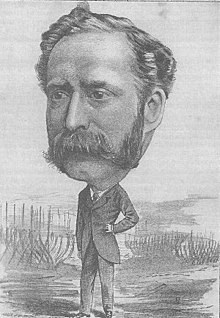Loading AI tools
From Wikipedia, the free encyclopedia
Sir William Pearce, 1st Baronet (8 January 1833 – 18 December 1888)[1][2] was a British shipbuilder, under whose management the Fairfield Shipbuilding and Engineering Company in Govan on the River Clyde became the leading shipbuilding company in the world.[3] He was later a Conservative Party politician.



Pearce was born at Brompton near Chatham in Kent, the son of Joseph George Pearce.[4]
He trained as a shipwright and naval architect at the Chatham Dockyard. After supervising the construction of HMS Achilles, the first ironclad warship built in Chatham, he moved in 1863 to Scotland to take up the post of surveyor to the Lloyd's Register on the Clyde.[5]
His career then developed rapidly. A year after arriving on Clydeside, he became general manager of Robert Napier and Sons, where he designed innovative fast, transatlantic liners for the Compagnie Générale Transatlantique. In 1869 he became a partner in John Elder & Co, and after the retirement of the other partners he became the firm's sole owner in 1878. In 1886, spending more time on his political career in London, he converted the business to a limited company, the Fairfield Shipbuilding and Engineering Company.[6] Pearce remained as chairman.[7]
Fairfield became a world leader in ship design and marine engineering, and was most famous for the development of the triple expansion engine. The shipyard and offices in Govan occupied a site of over 70 acres (28 ha), and employed up to 5000 workers. It built ships for the major shipping lines, including the Pacific Steam Navigation Company, the New Zealand Shipping Company, and the British and Africa Steam Navigation Company. Pearce was a major shareholder in the first of these clients, and was also chairman of the Guion Steamship Company, and of the Scottish Oriental Steamship Company.
As one of Govan's leading businessmen, Pearce took up public office as a Commissioner (councillor) for the Burgh of Govan.[7] He unsuccessfully contested the Glasgow constituency at the 1880 general election,[8] but after the redistribution of seats he was elected at the 1885 general election as Member of Parliament (MP) for the new Govan constituency.[2] His victory was narrow, with a majority of only 155 votes over his Liberal Party opponent.[9]
Pearce was re-elected at the 1886 election with a slightly increased majority of 362 votes,[9] and on 21 July 1887 he was made a Baronet, of Cardell in the County of Renfrew.[1][10]
Pearce died suddenly at the age of 55 in his home on Piccadilly in London,[5] on 18 December 1888.[1][2] He is interred at Gillingham, Kent. An independent memorial was erected in Craigton Cemetery in south-west Glasgow. The monument was designed by the architects Honeyman and Keppie.[11]
He was survived by his wife Dinah Elizabeth Socoter, who was originally from Gravesend in Kent. Their only child was William George Pearce, who succeeded to the baronetcy.
His estate was valued for probate purposes at £1,069,669.[5] His statue still stands at Govan Cross near the Pearce Institute, a building containing a public hall, library and other rooms, which was given to Govan by his widow.[6]
Seamless Wikipedia browsing. On steroids.
Every time you click a link to Wikipedia, Wiktionary or Wikiquote in your browser's search results, it will show the modern Wikiwand interface.
Wikiwand extension is a five stars, simple, with minimum permission required to keep your browsing private, safe and transparent.